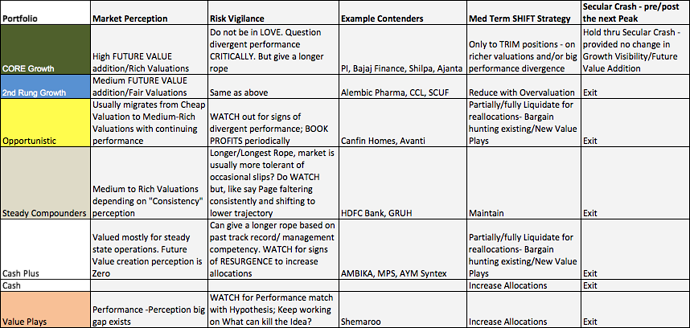H[quote=“vinoths, post:227, topic:4286”]
With current market situation, most of the stocks listed in your portfolio are expensive. Two common approach is,
a) Wait for good amount of market correction or black swan event to build such portfolio. Sitting with “Cash” when market is extremely valued is also important practice / behavior. I have failed to follow this multiple time  b) Use SIP method by weekly/monthly basis to build the portfolio over next 6 months to one year
b) Use SIP method by weekly/monthly basis to build the portfolio over next 6 months to one year
Can you share your thoughts based on current market situation and timing to build the portfolio?
Regards,Vinoth
[/quote]
As you rightly mentioned there are 2 key attributes - Patience and the Firepower (to Strike)
- Firepower
In continuously rising markets like now, I have found this becomes an easy job. Every few months some businesses become richly valued or keep getting valued higher -
Allocations jump from 15% to 25%+. There is only one option in such cases - continuously trim - I do these in tranches of 10%-20% at a time. Canfin, Avanti Feeds are examples. Core Portfolio Holdings like Bajaj Finance, Shilpa, PI I will give a longer rope, trim that much more slowly.
Once we understand the importance of having Cash, this becomes second nature. Mr D’s dictum to me was - in any stage of the Market you should have 20% Cash (near Cash). I took it as a Gospel. So I am always underinvested. I always have my Consulting income cashflows buttressing my fire-power all the time. Each one of us can work out how to maintain firepower at all times (based on individual circumstances), once one appreciates the importance of Cash - being King!
2.Patience
Has more to do with individual Temperament, and also understanding the Work Ethic required to remain Contented - with what you have :). When one has spent 4-5 years, I think Patience is also an Outcome of understanding oneself better, knowing what works for you and why. KNOWING what you are looking for and remaining true to PROCESS will help in developing patience.
Role of Contentment in developing the right Work Ethic - If temperamentally we are always jumping around/salivating at the next opportunity, we cant remain unaffected. No one is a super-human, so it pays to avoid too many temptations. Not getting easily excited - being very CLEAR about what excites you the most. Working hard only on that excitement - helps keep out lot of temptations (NOISE).
Also the real appreciation of the miracle of compounding helps. Appreciating that Compounding results are back-ended. 20% compounding over 10 years is 6x but in 20 years in 36x, and in 30 years?? Even a 15% compounding is 64x in 30 years. provided you can do it consistently. Patience is key to Consistency, Sustainability, and Longevity.
SIP in good businesses is workable - provided one is clear about Value/Margin of Safety. Else, it can be hazardous in a continuously rising market. Only one Secret to Outperformance - consistently UNDERPAYING. Michael Maubussin - I like his very practical thoughts - says Value and Competitive Position are joined at the Hip. If I take HM’s Reducing Risk through understanding Stability and Dependability of Value as a Gospel- I take Maubiussin’s this statement dead seriously too.
I can get better at understanding Value - only if I get better and work harder at understanding Stability of the Industry and Competitive Position/Strategy of the business in the Industry.
Became a big sermon  . Didn’t mean it to. Hope something in above resonates with you and help in formulating your own responses to a simple but difficult job.
. Didn’t mean it to. Hope something in above resonates with you and help in formulating your own responses to a simple but difficult job.
 . The Proof of the Pudding is in the Eating …and that to me means Execution…having the patience, and knowing when to strike !!
. The Proof of the Pudding is in the Eating …and that to me means Execution…having the patience, and knowing when to strike !!


